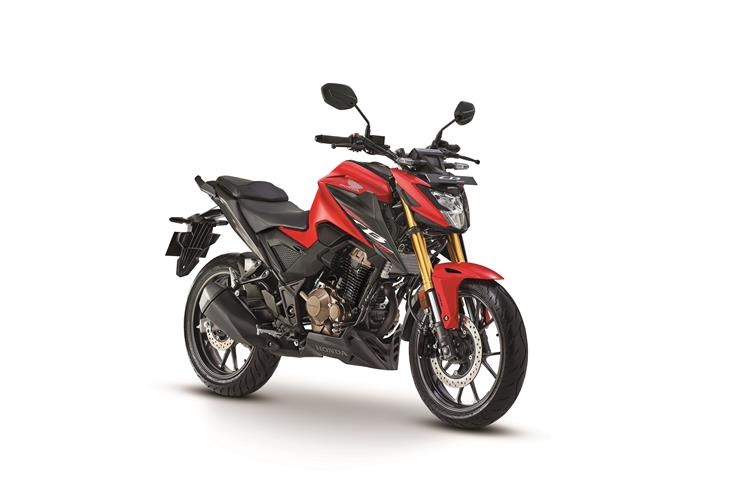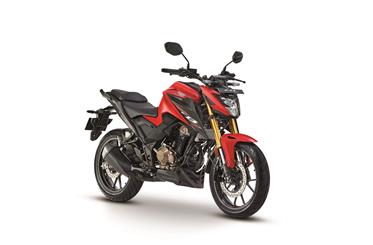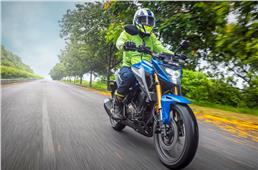Loan Amount Lakhs
10 Thousand
1 Crore
Interest Rate Percentage %
1%
15%
Loan Tenure Years
1 Yr
7 Yr
Principal Amount
0
Rate of Interest
0%
Tenure
0 Year
EMI Amount
0
Total Interest Paid
0
Total Amount
0
The lower middleweight market (250-500cc) is one of the fastest growing in India at the moment, but for all its might, Honda hasn't really b...
The lower middleweight market (250-500cc) is one of the fastest growing in India at the moment, but for all its might, Honda hasn't really been able to carve out a slice of this juicy pie for itself. The H'ness CB350 was touted as the bike to challenge RE's stranglehold over this segment, but it was never really able to fully live up to that promise, being limited to only Honda's premium BigWing showrooms. And as great a motorcycle as the CB300R is, it's simply priced too close to more capable competition to be successful. To launch a fresh attack on the segment, the Japanese giant has rolled out a new motorcycle that seems to be trying to rectify the CB300R's primary drawback. Called the CB300F, it's also a naked streetfighter like its sibling, but takes a simpler approach to things, and resultantly, also comes in a good Rs 62,000 below the CB300R.
In isolation though, the Rs 2.26 lakh price tag (Rs 2.29 lakh if you want the Pro variant with Bluetooth connectivity) for the CB300F still comes across as quite steep when you look at the other numbers for this bike. At 293cc, the F's engine is slightly larger than the R's, but it features simpler construction – SOHC architecture compared to the R's DOHC, and air- and oil-cooling as opposed to liquid-cooling. Which is what explains its power and torque deficit. Unfortunately though, the CB300F is not only down on output compared to its sibling, but also compared to its external competition. With 24.5hp on tap, the CB is beaten by even smaller 250cc machines like the Suzuki Gixxer 250 (26.5hp) and KTM 250 Duke (29.91hp). This CB's output is exactly the same as that of the Bajaj Pulsar 250. And when placed against a direct rival – a 300cc streetfighter like the BMW G 310 R – the deficit is a whole 10hp!

Worth noting, however, is the fact that the Honda produces its peak power and torque a good deal lower in the rev range than most rivals. And you feel this when you climb aboard. The CB's 25.6Nm torque figure is more respectable in the company it keeps, and the bottom and mid-range pull of the engine is pleasing. This should make the motor quite well suited to ferrying you around in city traffic, and the light clutch helps here too. But overall performance from the engine still falls short of what you’d want and expect at this price and displacement point, and it certainly doesn't sustain into the latter third of the tachometer, where this CB begins to lose steam.
Of course, there's more to motorcycles than just power figures and acceleration. But considering all the literature that Honda itself has created around the CB300F, showering it with tags like 'formidable', 'furious' and 'fast', the performance from the engine doesn’t quite live up to the hype.
The hope after viewing the spec sheet was that the humble output figures would pave the way for other strengths like tractability, and refinement, a traditional Honda hallmark. But these expectations didn’t quite materialise once we set off. The motor is quite tractable, but when it comes to refinement, this engine is doing a disservice to the badge on the tank. There is a hint of buzz at most touch points, at all points in the rev range. But once past about 5500rpm, the vibrations really make themselves felt, and holding these engine speeds almost feels unkind to the motor.
This is an issue when it comes to highway cruising, because even in 6th gear (which is a rather tall ratio), you can only go as fast as 90kph without the vibrations rearing their head. By 100kph, you can definitely feel the buzz throughout the bike, and by 110kph, things feel very buzzy and busy. It doesn't help that by this point, the engine is beginning to run out of breath as well, and I don’t think you'll be able to go much higher than the 130kph mark on flat ground. This motor feels at its best when ridden at city speeds, but that's hardly the ideal use case for what's touted as a sporty 300cc streetfighter.
One of the few areas in which this bike somewhat lived up to its tags, is handling. The hardware is good – a Showa USD fork, a preload-adjustable monoshock and chunky radial tyres at both ends. Once the polish was scrubbed off the rubber, the CB300F proved to be quite a natural handler, with reasonably quick steering and good grip from the MRF Revz tyres even in the wet. It's only at high lean angles that the bike begins to feel a little twitchy as you approach the limit. For everyday usage, the CB comes across as quite light and manageable, with a lithe 153kg kerb weight and a very accessible 789mm seat height, both of which make it great for shuffling through the city.

But that same suspension that contributed to neat handling doesn't do quite as well at ride quality. It’s evidently quite a soft set-up – it squishes quite easily when pressing down on the bike at a standstill, and most of the travel is lost to sag with two heavy occupants on board. But despite this, it doesn't do a great job of absorbing bumps, and it's certainly not what you'd call plush. It isn't harsh or jarring either, but anything more than small bumps is definitely transferred through to you, though the suspension does round them off to some extent.
Where this bike does better at comfort is when it comes to seating. We only had a short time in the saddle so a clearer idea of long-distance comfort will only come later, but the first impressions are good. You sit quite nice and upright – there isn't much of a downward reach to the high-placed handlebars, and your upper body is quite erect, but the foot pegs are a little rear set, which adds an element of sportiness to the overall position. The seat itself is quite roomy, and importantly, this bike feels noticeably larger and more accommodating than the CB300R, which comes across as a considerably more taut and compact motorcycle.

Unfortunately, the brakes don't live up to the promise of sportiness either – there is adequate, but not excellent, stopping power on offer. The bigger issue, however, is that the feel at the lever is quite spongy and robs you of confidence.

The one area where the CB300F’s sportiness cannot be denied, is when it comes to its appearance, because this is quite a handsome and aggressive design. Elements like the low-slung headlight, the golden upside-down fork and the sharp, intricate, 'floating' tank extensions lend it not only a premium air, but also an intentful stance. The rear of the motorcycle isn't quite as dramatic; the step between the seats is gentle and the tail section isn't very steeply raked, but the stubby exhaust can and sleep tail give the bike a nice, clean look. At the end of the day though, as attractive as this design is, there is no getting around the fact that it looks quite a bit like a Hornet 2.0 with chunkier tyres, save for a few elements like the tail-lamp.

It certainly packs in more features than a Hornet, though. The all-digital LCD instrument cluster features Bluetooth on the top variant (the only difference between the two versions) and Honda is also giving you all-LED lighting, a type-C USB charger, an assist-and-slipper clutch, dual-channel ABS and traction control. Although the value of the latter is questionable, considering the performance levels on offer here, it's still a nice safety feature to have.
Had Honda hit its usual mark when it comes to engine refinement, the CB300F would've made for a decent motorcycle for somebody not interested in having the sportiest experience in the middleweight segment. It has its share of positives: great road presence, comfortable seating, and the fact that it’s light and easy to ride. With a smooth engine, it could have made for a good big-city bike. But once you bring in the price tag and see where it stands with respect to its competition, this does come across as quite an underwhelming motorcycle.
For almost Rs 45,000 less, Suzuki is offering you a great all-rounder in the form of the Gixxer 250, which feels equally quick, and yet, a great deal smoother. And if a genuine premium streetfighter experience is what you're after, then the KTM 250 Duke is just Rs 11,000 more, or you could even have something like the BMW G 310 R for under Rs 40,000 more. The CB300F will be exclusively retailed out of Honda's BigWing network, and while only a longer ride will give us a full picture of this bike, our first impressions suggest that those 100-odd dealerships across the country are going to have a bit of a hard sell on their hands.
Fuel Type
Petrol
Max Power
24.4hp at 7500rpm
Max Torque
25.6Nm at 5500rpm
Gearbox Type
Manual
Warranty Duration
NA Years
Type
Motorcycle
Number Of Gears
6
Official Fuel Economy
kpl
Fueling
Fuel-Injected
Combined Braking System
ABS
Dual channel
Wheelbase
1390 mm
Seat Height
789 mm
Ground Clearance
177 mm
Kerb Weight
153 kg
Fuel Type Propulsion
Petrol
Engine Displacement
293cc
Valvetrain
4 Valves/Cyl
Fueling
Fuel-Injected
Cooling
Air/Oil Cooled
Engine Type
1 cylinder
Aspiration
Naturally Aspirated
Max Engine Power
24.4hp at 7500rpm
Max Engine Torque
25.6Nm at 5500rpm
Gearbox Type
Manual
Number of Gears
6
Slipper Clutch
Reverse Gear
Transmission Type
Chain drive
Clutch
Wet, multiplate clut
Fuel Tank Size
14.1 litres litres
Official Fuel Economy
kpl
Claimed Charging Time
hrs
Chassis Type
Diamond
Front Suspension Type
Upside-down fork
Rear Suspension Type
Monoshock
Electronic Suspension
Wheels Type
Alloy
Wheel Construction
Alloy
Tyre type
Tubeless
Tyre Make and Model
MRF Revz C
Front Tyre Size
110/70-R17
Rear Tyre Size
150/60-R17
Radial Tyres
Front Wheel Size
17 inch
Rear Wheel Size
17 inch
Front Brakes
Disc
Rear Brakes
Disc
Front Brake Type
Disc
Front Brake Size
276mm
Rear Brake Type
Disc
Rear Brake Size
220mm
Combined Braking System
Anti Lock Brakes ABS
Dual channel
Cornering ABS
Hazard Lights
SideStand Indicator
SideStand Engine CutOff
Traction Control
Wheelie Control
Engine Brake Control
Slide Control
Inertial Measurement Unit
Adaptive Cruise Control
Cornering Headlamps
Tyre Pressure Monitoring System
Blind Spot Monitor
Lane Keep Assist
Pass Light Switch
Self Cancelling Indicators
Backlit Switchgear
Brake Lock Clasp
Underseat Storage Light
Engine Kill Switch
Audio System
USB Charging Port
Charging Socket
Bluetooth Connectivity
Bluetooth Telephone Function
Navigation
Launch Control
Steering Damper
Cruise Control
Hill Hold Assist
TFT Colour Instrument Cluster
Touchscreen
Trip Meter
Average Speed
Fuel Gauge
Distance to Empty Range
Service Due Indicator
Engine Motor Temperature Gauge
Ambient Temperature Gauge
Variants
Price
Compare
Variants
Price
Compare

Honda Bikes CB300F
Published On Aug 14, 2022 01:00:00 PM
Here’s what Honda's fourth offering in the 300-400cc segment brings to the table.
3 Bikes


